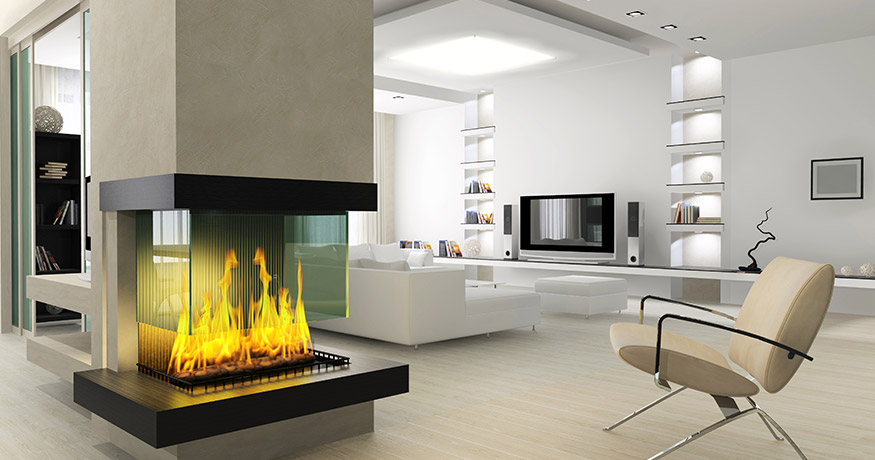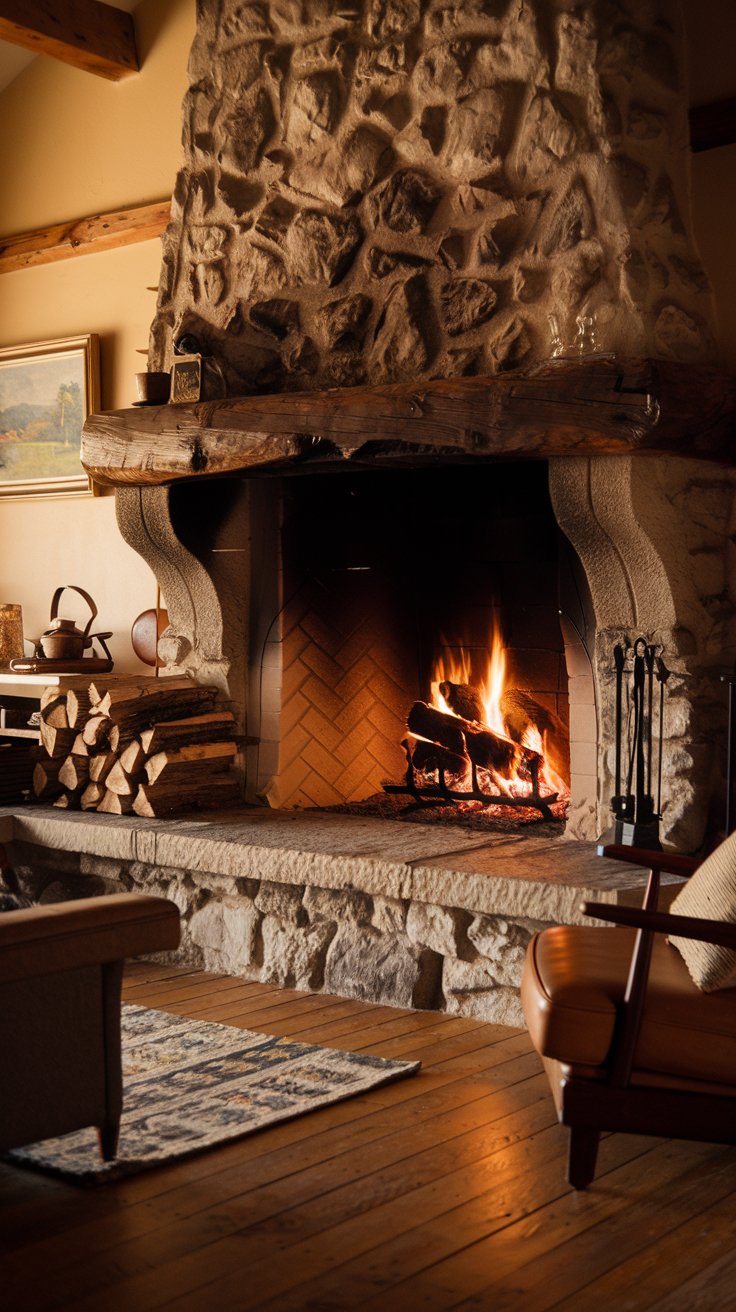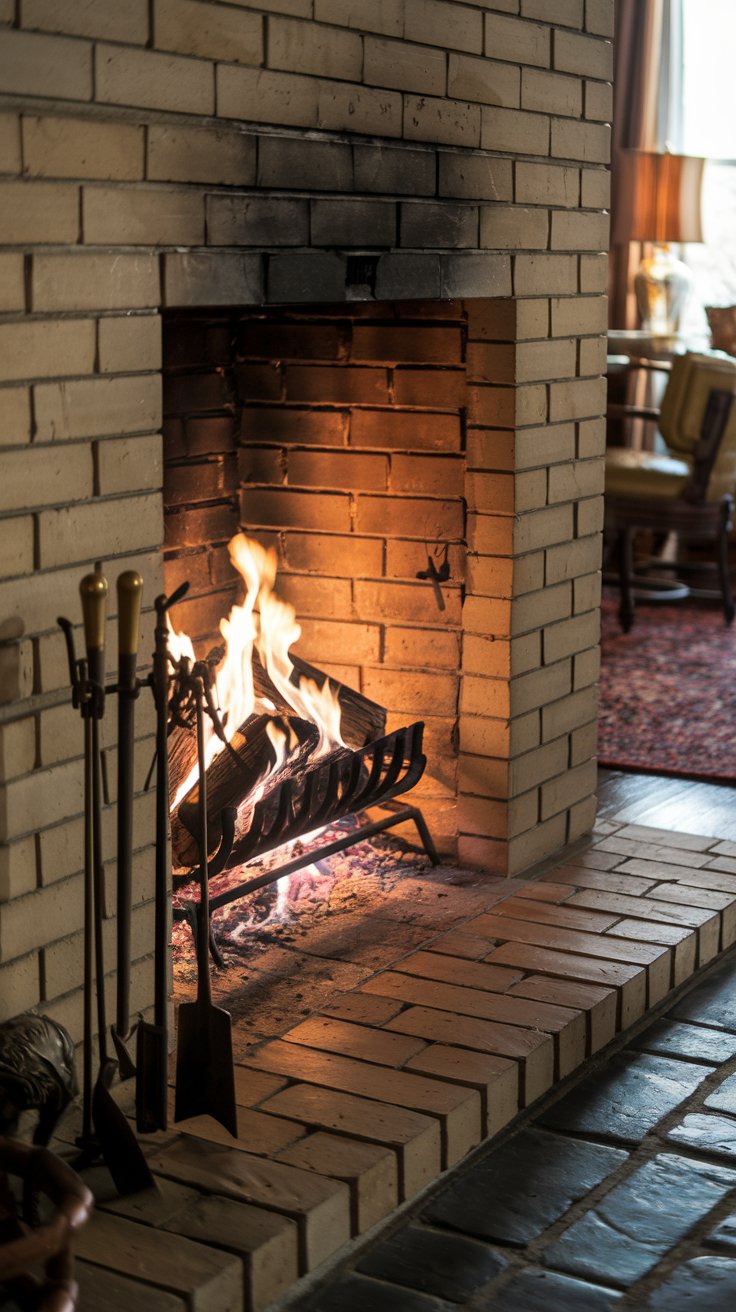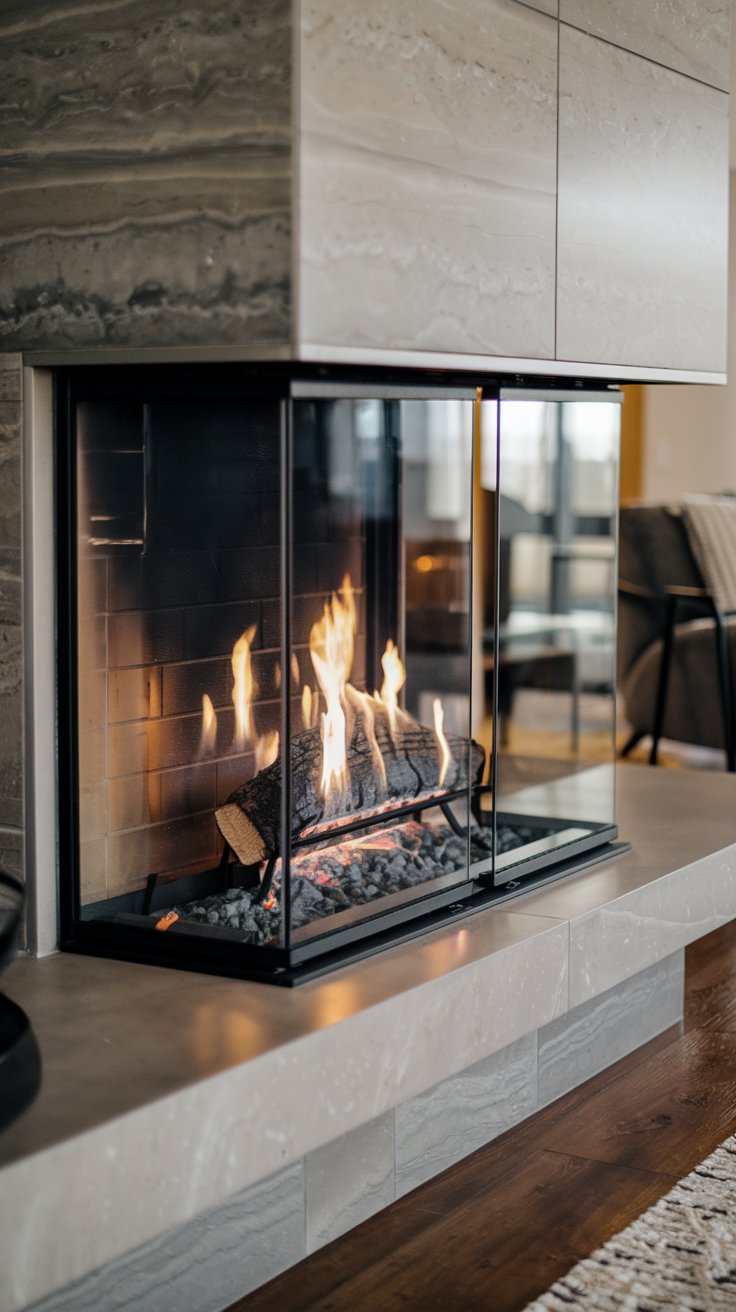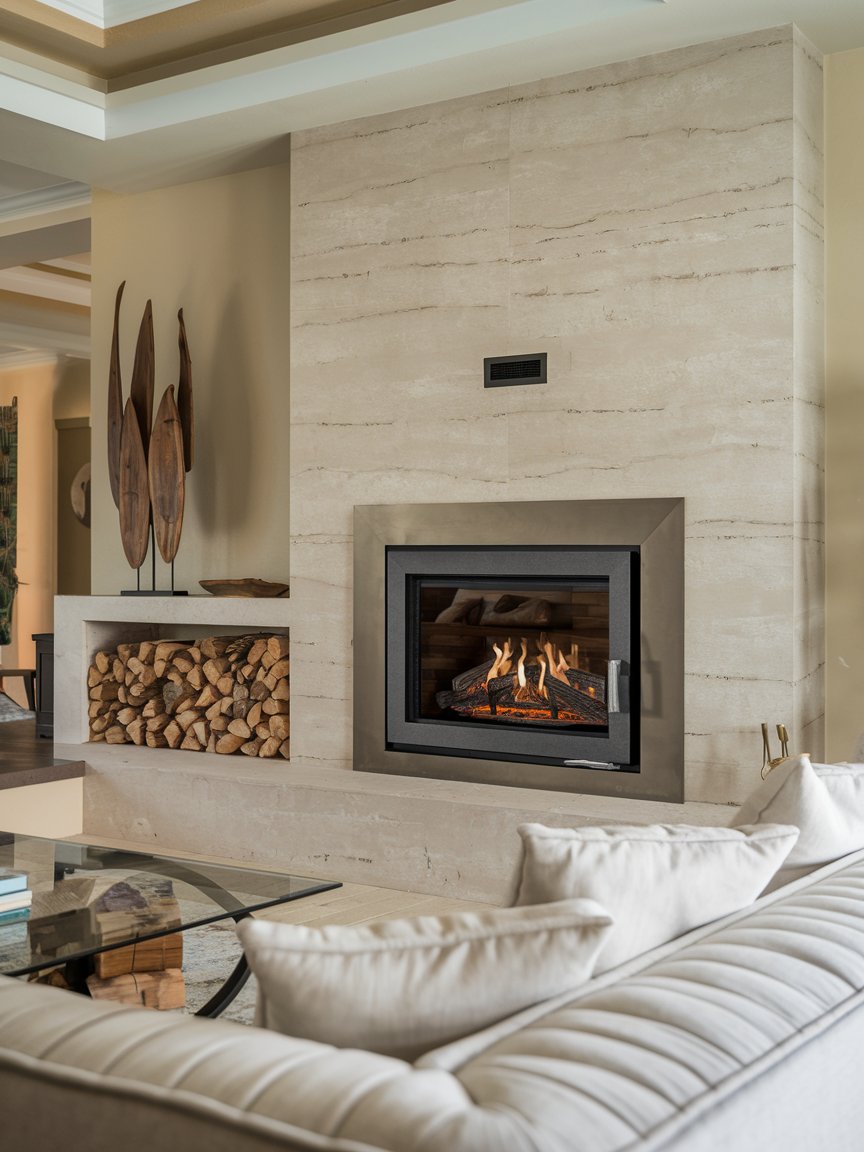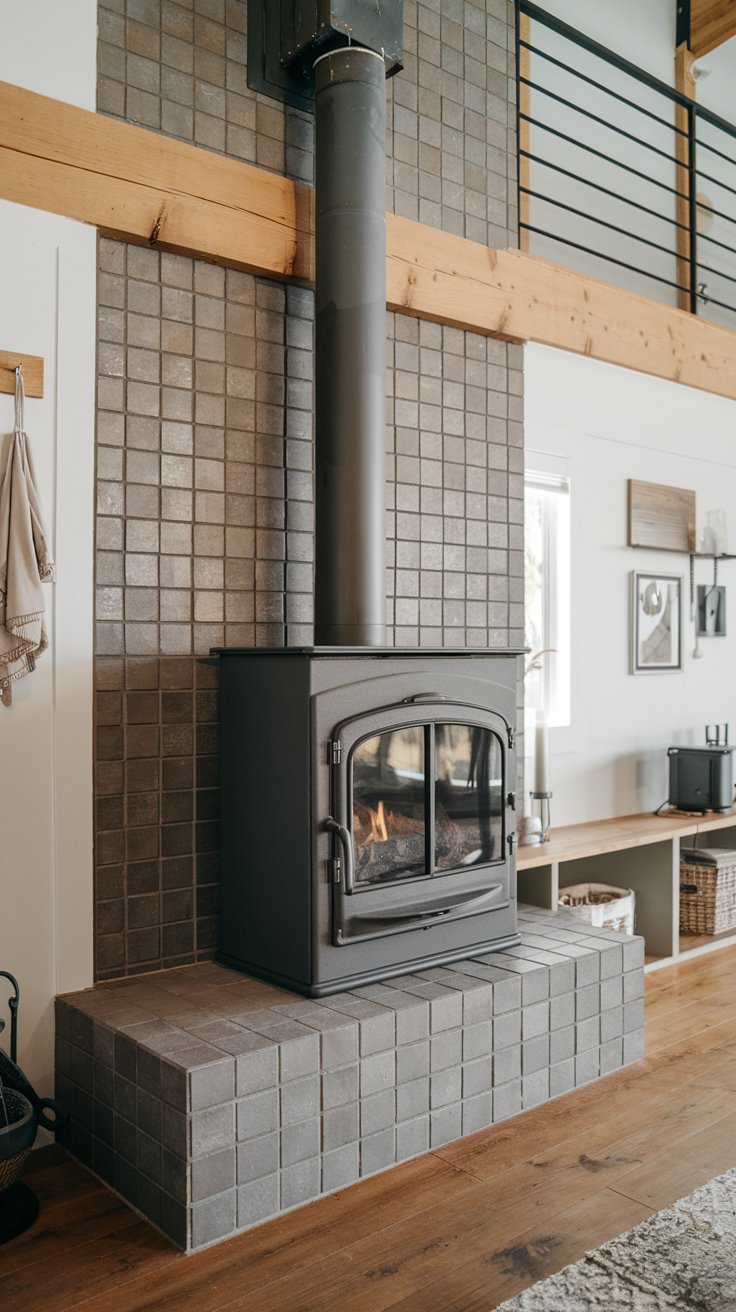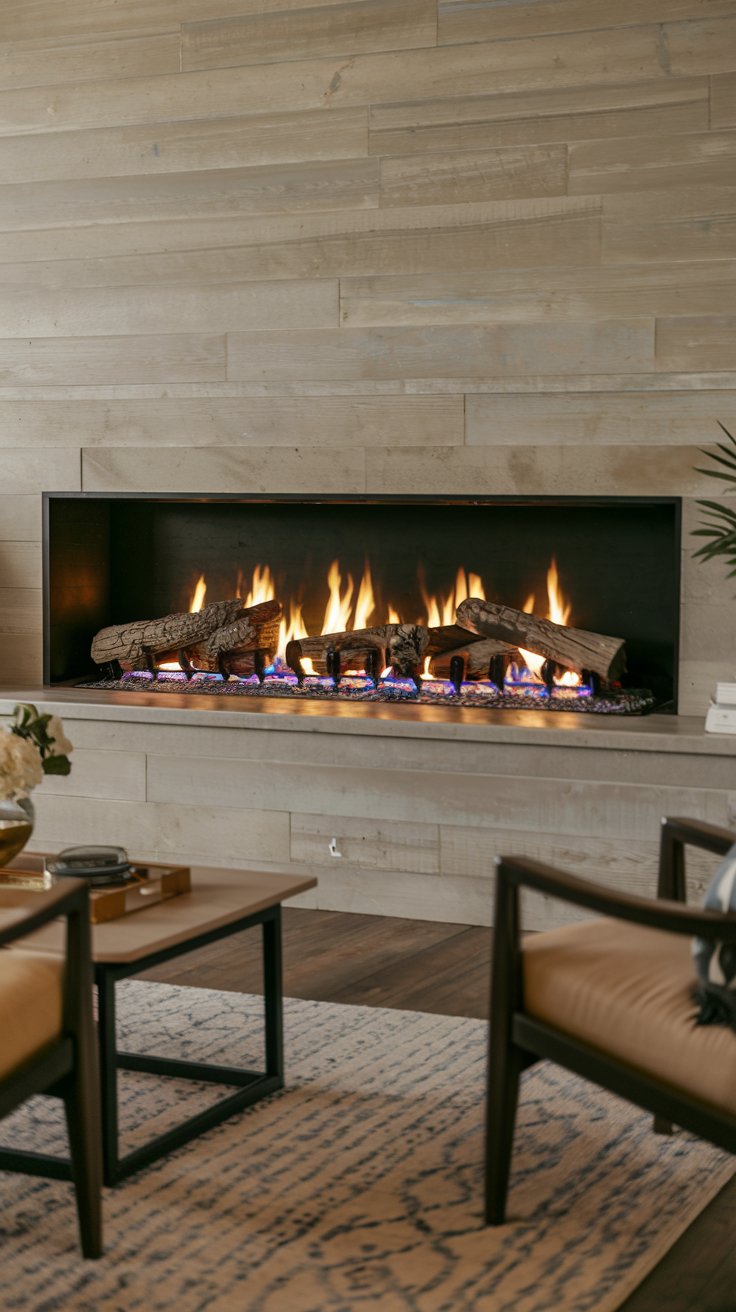There are four main categories of fireplaces that branch into 14 distinct variations for your home.
Wood-burning options include traditional open-hearth, closed-hearth, inserts, and prefabricated units, while gas fireplaces offer direct vent, ventless, and B-vent configurations.
Electric choices feature wall-mounted, inset, and freestanding designs, and alternative fuel options encompass ethanol, pellet, and gel installations.
Each type varies considerably in efficiency (10-100%), heat output (1,500-90,000 BTUs), and installation requirements, with additional style variations including masonry, two-sided, and outdoor configurations.
Understanding the technical specifications and requirements of each option will help you select the ideal fireplace solution.
Wood-Burning Fireplaces
When considering wood-burning fireplaces, you’ll find four main types to choose from: traditional open-hearth designs, closed-hearth systems, fireplace inserts, and prefabricated units.
While open-hearth fireplaces offer that classic, wide-open design with natural ambiance, they’re typically less efficient than their closed-hearth counterparts, which focus heat output more effectively into your living space.
You can enhance an existing fireplace’s performance with an insert, or opt for a prefabricated system that’s easier to install, though installation costs for any type will generally range from $8,000 to $21,000 including labor.
Open-Hearth Fireplaces
For centuries, open-hearth fireplaces have remained the most traditional and recognizable choice for home heating. These classic installations feature a large, open fire chamber that creates an authentic crackling fire experience, producing between 20,000 and 40,000 BTUs of heat output.
While you’ll love the traditional ambiance, it’s important to understand that open-hearth fireplaces operate at only 10-15% efficiency, as most of the heat escapes through the chimney system.
You’ll need to invest between $7,000 and $15,000 for full masonry construction, which includes a complete chimney system. Additionally, you’ll need to commit to regular maintenance to keep your fireplace functioning safely and effectively.
Despite their relatively low efficiency, these fireplaces continue to be valued for their timeless appeal and ability to serve as a striking design focal point.
Closed-Hearth Fireplaces
Looking to improve upon traditional fireplace efficiency? Closed-hearth fireplaces, featuring glass doors that enclose the fire, offer a significant upgrade with efficiency ratings of 20-30%, which is considerably higher than their open-hearth counterparts.
Benefits can be found from the enhanced control over airflow and combustion, while the unit can generate impressive heat output of up to 70,000 BTUs when properly designed.
While you’ll still need a complete chimney system for proper ventilation, the glass enclosure helps regulate the burning process and minimize heat loss.
When considering installation, you can expect costs between $3,000 and $7,000 for prefabricated units, though this investment translates to better heat retention and fuel efficiency.
The sealed glass doors create a safer barrier between your living space and the fire while maintaining ideal burning conditions.
Fireplace Inserts
Transform your existing fireplace into a high-performance heating system with a wood-burning fireplace insert.
These specialized units, designed to fit seamlessly into your current fireplace opening, can dramatically enhance heating efficiency from typical fireplace levels to an impressive 65-80% while considerably increasing heat output throughout your living space.
When considering an insert installation, you’ll need to factor in both the unit cost, which typically ranges from $2,000 to $4,000, and additional installation expenses.
During the installation process, your chimney may require professional relining to guarantee proper venting and meeting safety standards.
Prefabricated Fireplaces
Prefabricated fireplaces offer a practical alternative to traditional masonry units, combining modern engineering with easy installation.
These factory-built systems typically cost between $2,000 and $5,000 for basic installation, making them a cost-effective option for homeowners seeking to add warmth and ambiance to their living spaces.
These units are particularly versatile due to their lightweight construction, which allows for installation in locations where traditional masonry fireplaces aren’t feasible.
While efficiency ratings range from 20-40%, the exact performance depends on the specific design and model you choose.
Key advantages of prefabricated fireplaces include:
- Metal chimney systems that are easier to install than masonry
- Various sizes and styles to match your home’s design
- Lower installation costs compared to traditional brick fireplaces
Gas Fireplaces
When considering gas fireplaces for your home, you’ll encounter three main types: direct vent systems that offer sealed, efficient operation, ventless units that don’t require chimneys, and natural vent (B-vent) options that use traditional chimney systems.
Gas fireplaces provide excellent heat transfer efficiency while requiring minimal maintenance, making them a practical choice for modern homes.
While you might spend anywhere from $229 to $7,900 for a B-vent system before installation, you’ll gain the convenience of adjustable heat settings and easy operation, though you’ll notice they lack some of the natural ambiance of wood-burning fireplaces.
Direct Vent Gas Fireplaces
Direct vent gas fireplaces represent one of the most efficient and versatile heating options for modern homes.
With efficiency ratings of 70-85%, these systems employ sealed combustion technology and dual-wall venting to maximize heat output while maintaining indoor air quality.
Installation costs can range from $3,000 to $7,500, including professional setup.
These advanced heating systems offer several key advantages:
- Heat output of 20,000-40,000 BTUs provides consistent warmth for your living spaces
- Flexible installation options with both horizontal and vertical venting configurations
- Sealed combustion system greatly reduces indoor air quality concerns
The dual-wall venting system enables you to place your fireplace in various locations throughout your home, as it doesn’t require a traditional chimney setup.
Another advantage is the combination of safety features and installation flexibility that direct vent technology provides.
Ventless (Vent-Free) Gas Fireplaces
Ventless gas fireplaces offer a unique blend of high efficiency and simplified installation, operating without the need for external venting or chimneys.
These units achieve nearly 100% efficiency since all heat remains in your living space, while installation costs typically range from $2,000 to $5,000.
You’ll need to evaluate several important factors before choosing a ventless system.
Due to safety regulations, these fireplaces are limited to 40,000 BTUs maximum heat output, and they’re not permitted in all jurisdictions.
You’ll need to verify your local building codes and confirm proper room sizing for safe operation.
While these systems provide efficient heating, they’ve generated controversy regarding indoor air quality concerns.
It’s essential to weigh these considerations against the benefits of high efficiency and lower installation costs when making your decision.
Natural Vent (B-Vent) Gas Fireplaces
Through a combination of traditional venting and modern convenience, natural vent gas fireplaces offer homeowners a practical option for converting existing wood-burning fireplaces.
These units employ your existing chimney or B-vent pipe system for exhaust, supplying heat outputs between 20,000-35,000 BTUs while operating at 50-70% efficiency.
You’ll want to take into account the installation costs, which typically range from $2,000 to $5,500, including professional setup.
Key considerations for B-vent fireplaces include:
- Annual inspection requirements to guarantee proper venting system function
- Limited placement options due to the need for vertical venting
- Higher efficiency than wood fireplaces but lower than direct vent models
While these systems aren’t as efficient as direct vent options, they’re often the most practical choice when you’re looking to retrofit an existing fireplace, providing reliable heat with modern gas convenience.
Electric Fireplaces
When it comes to electric fireplaces, you’ll find several versatile options to match your home’s style and space requirements, including wall-mounted units that create a modern focal point, and inset models that offer a clean, built-in look.
You can also consider freestanding electric stoves that provide portability and traditional charm, or electric fireplace TV stands that combine entertainment functionality with supplemental heating.
These electric options come with realistic flame effects and convenient features, making them particularly appealing if you’re looking for a low-maintenance heating solution that doesn’t require venting or complex installation.
Wall-Mounted Electric Fireplaces
Many homeowners are turning to wall-mounted electric fireplaces as a stylish and practical heating solution. These modern units, which install similarly to mounting a flat-screen TV, can generate between 4,000 and 5,000 BTUs of supplemental heat while offering customizable flame effects and colors to enhance your room’s ambiance.
Premium manufacturers like MagikFlame have revolutionized the market with their HoloFlame technology, which creates ultra-realistic flame effects using advanced holographic projection.
- Installation is typically DIY-friendly, requiring basic tools and wall-mounting hardware.
- Prices range from $300 for basic models to $2,500 for premium units with advanced features, with MagikFlame models offering exceptional realism in the mid to upper range.
- Heat output can effectively warm small spaces while maintaining energy efficiency.
When you’re considering a wall-mounted electric fireplace, you’ll appreciate its space-saving design and versatility, as it doesn’t require ventilation or complex installation procedures. Companies like MagikFlame offer comprehensive installation guides and customer support to ensure proper setup.
These units serve as both functional heating appliances and sophisticated wall decorations, making them particularly suitable for apartments, condos, or rooms where traditional fireplaces aren’t feasible.
MagikFlame’s collection, for instance, features various styles from contemporary to transitional, allowing homeowners to match their existing décor while enjoying the benefits of modern electric fireplace technology.
Inset (Recessed) Electric Fireplaces
For homeowners seeking an even more integrated appearance than wall-mounted options, inset electric fireplaces offer the ultimate built-in solution.
These recessed units, which typically cost between $500 and $3,000 before installation, require construction work to create a dedicated cavity within your wall.
Inset electric fireplaces deliver impressive heat output, generally ranging from 4,000 to 8,000 BTUs, while providing the flexibility to adjust both heat and flame settings to your preferences.
The design possibilities allow you to recreate the look of a traditional fireplace opening, creating a seamless, sophisticated focal point in any room.
Since they’re built directly into the wall, you’ll achieve a clean, contemporary aesthetic that doesn’t sacrifice any floor space or protrude into your living area.
Freestanding Electric Fireplaces
Selecting a freestanding electric fireplace offers unmatched flexibility for your heating and décor needs. These portable units, which typically generate between 4,000-5,000 BTUs of heat output, can be easily relocated throughout your living space without requiring professional installation or permanent modifications to your home’s structure.
- Available in various styles, including traditional stove designs that complement both modern and classic décor schemes.
- Installation-free operation requires only a standard electrical outlet, making these units ideal for renters or homeowners seeking portable heating solutions.
- Price points ranging from $200 to $1,000 allow you to select a model that aligns with both your budget and specific heating requirements.
These units are particularly practical when you need supplemental heat in different rooms throughout the day, as their portable nature allows for efficient space heating wherever it’s needed most.
Electric Fireplace TV Stands
Electric fireplace TV stands deliver space-saving innovation by merging entertainment storage with supplemental heating. These dual-purpose units, which require no complex installation beyond basic assembly, provide convenient media organization while producing 4,000-5,000 BTUs of warmth through their integrated electric fireplaces.
These versatile pieces are available across a wide price range, from $300 entry-level models to premium options reaching $2,000, with costs typically reflecting size differences and construction quality.
The built-in fireplaces come with adjustable settings, allowing you to control both heat output and flame display intensity to match your comfort needs and aesthetic preferences.
For smaller living spaces where you’re looking to maximize functionality without sacrificing style, these combination units offer an efficient solution that doesn’t compromise on either entertainment storage or supplemental heating capabilities.
Alternative Fuel Fireplaces
If you’re exploring alternatives to traditional wood-burning fireplaces, you’ll find several innovative options including ethanol fireplaces, which burn clean renewable fuel without requiring ventilation.
Pellet stove fireplaces efficiently burn compressed wood or biomass materials, and gel fuel fireplaces are another option. These alternative fuel solutions offer environmentally conscious heating choices while providing the ambiance of real flames.
Many can be installed in locations where traditional fireplaces aren’t feasible. You’ll appreciate that these modern alternatives typically produce fewer emissions than conventional fireplaces, with pellet stoves being particularly efficient and ethanol units offering the most flexibility regarding placement and installation requirements.
Ethanol Fireplaces
For homeowners seeking an eco-friendly and versatile fireplace option, ethanol fireplaces offer a modern alternative to traditional heating solutions.
These ventless units, which burn clean bioethanol fuel, can be installed virtually anywhere in your home without requiring a chimney or complex venting system. While the initial investment ranges from $500 to $5,000, you’ll benefit from flexible placement options and environmentally conscious heating.
Key features of ethanol fireplaces include:
- Heat output between 3,000 and 20,000 BTUs, depending on the model size
- Ventless operation that allows for installation in any room
- Clean-burning renewable fuel that produces no smoke or ash
While you’ll enjoy the convenience and eco-friendly aspects, it’s important to take into account that ethanol fireplaces typically generate less heat than conventional units, and fuel costs may be higher.
Pellet Stove Fireplaces
Modern pellet stove fireplaces combine the traditional appeal of wood-burning units with advanced technology to deliver exceptional heating efficiency.
You’ll benefit from their 70-83% efficiency rating while producing fewer emissions than conventional wood fireplaces. These units, costing between $1,500-$3,500 before installation, require electricity to operate their automated feed mechanisms and blowers.
| Feature | Specification |
|---|---|
| Heat Output | 8,000-90,000 BTUs |
| Fuel Type | Wood/Biomass Pellets |
| Efficiency | 70-83% |
| Power Source | Electric |
| Maintenance | Regular Cleaning |
While they provide significant heating capacity ranging from 8,000 to 90,000 BTUs depending on size, you’ll need to take into account pellet storage space and commit to regular maintenance.
The automated feeding system guarantees consistent heat output, but you’ll need a reliable power source to maintain operation.
Gel Fuel Fireplaces
Unlike their pellet-burning counterparts, gel fuel fireplaces offer a uniquely portable and flexible heating solution for your home.
Operating on alcohol-based gel fuel canisters, these ventless units provide 1,500-3,000 BTUs of heat output per can, making them suitable for creating ambiance rather than serving as a primary heat source.
- You’ll find installation requirements are nonexistent, allowing you to place the unit anywhere in your living space.
- Expect to invest between $300-$1,500 for the fireplace unit itself, though you’ll need to factor in ongoing fuel costs.
- Each fuel canister provides 2-3 hours of burn time, requiring replacement for extended use.
These fireplaces combine convenience with modern design, though they’re limited in their heating capacity.
When selecting a gel fuel fireplace, you’ll want to take into account the trade-off between portability and heat output for your specific needs.
Fireplace Styles and Designs
When choosing a fireplace, there is a wide variety of styles and designs to match your home’s structure and personal preferences.
Masonry fireplaces, constructed with brick or stone, are permanently integrated into your home’s design, while prefabricated models offer easier installation and flexibility.
If you’re looking to maximize viewing angles, consider a two-sided fireplace that’s visible from adjacent rooms, or opt for a space-efficient corner design that fits seamlessly into room intersections.
For those seeking versatility, freestanding stoves provide mobility and can be repositioned as needed, while wall-mounted units, typically powered by electricity or gas, don’t require a chimney system.
If you’re interested in outdoor entertaining, exterior fireplaces can create an inviting atmosphere for your outdoor living spaces, combining functionality with design appeal.
Efficiency and Heat Output Comparison
| Fireplace Type | Efficiency (%) | Heat Output (BTU) |
|---|---|---|
| Open-Hearth Fireplaces | 10-15% | 20,433 BTU |
| Closed-Hearth Fireplaces | 70-85% | 55,000 BTU |
| Fireplace Inserts | 71.3-80% | 25,000-85,000 BTU |
| Prefabricated Fireplaces | 70-80% | 20,000-60,000 BTU |
| Direct Vent Gas Fireplaces | 70-78% | 30,000-65,000 BTU |
| Ventless Gas Fireplaces | 99.9% | 20,000-40,000 BTU |
| Natural Vent Gas Fireplaces | 80% | 20,000-60,000 BTU |
| Wall-Mounted Electric Fireplaces | 100% | 4,000-9,000 BTU |
| Inset Electric Fireplaces | 100% | 4,600-10,000 BTU |
| Freestanding Electric Fireplaces | 100% | 4,000-10,000 BTU |
| Electric Fireplace TV Stands | 100% | 4,500-10,000 BTU |
| Ethanol Fireplaces | 100% | 5,000-53,800 BTU |
| Pellet Stove Fireplaces | 70-90% | 8,000-90,000 BTU |
| Gel Fuel Fireplaces | 9,000 BTU |
Understanding fireplace efficiency can greatly impact your heating costs and environmental footprint.
When comparing heat output and efficiency across different types, you’ll find that electric fireplaces convert 100% of electricity into heat, making them highly efficient for indoor warming.
Gas fireplaces deliver superior heat transfer and higher BTUs compared to wood-burning options, while traditional wood-burning hearths typically operate at only 10-15% efficiency.
- Electric fireplaces provide consistent, measurable heat output with no energy loss during conversion.
- Gas units offer excellent heat distribution and controlled temperature management.
- Pellet stoves combine high efficiency with environmental responsibility, using compressed wood waste as fuel.
Your choice will depend on balancing factors like fuel availability, operating costs, and heating requirements.
Consider that while wood-burning fireplaces create an authentic ambiance, they’re the least efficient option for home heating.
Installation Considerations
The right fireplace means little without proper installation planning. You’ll need to evaluate whether you’re working with an existing chimney or starting fresh, as this greatly impacts your options and costs.
Before proceeding, confirm you’ve researched local building codes and obtained necessary permits for your specific fireplace type.
| Installation Factor | Existing Home | New Construction |
|---|---|---|
| Chimney Requirements | Inspection needed | Fresh installation |
| Venting Options | Limited by structure | Fully customizable |
| Cost Considerations | Higher for retrofits | Lower for integration |
Professional installation is essential, particularly for gas fireplaces, where proper venting and gas line connections require specialized knowledge. Y
our installer must verify proper clearances, confirm adequate ventilation, and validate that all materials meet safety standards. When retrofitting an existing chimney, they’ll need to assess its condition and compatibility with your chosen fireplace system.
Maintenance and Safety
Proper maintenance guarantees your fireplace delivers safe, efficient warmth year after year. Each type requires specific care – wood-burning units need regular cleaning of the firebox and chimney to prevent dangerous creosote buildup, while gas fireplaces require periodic inspection of connections and valves, along with gentle cleaning of decorative elements.
Electric models are the most low-maintenance, typically needing only occasional dusting.
Essential safety equipment for your fireplace includes:
- A complete set of fireplace tools, including a shovel and brush for ash management
- A metal ash bucket with a tight-fitting lid for safe disposal of hot ashes
- A reliable flashlight for thorough inspections of the firebox and chimney
Remember to schedule professional inspections annually and address any maintenance issues promptly to guarantee your fireplace’s continued safe operation.
For essential safety tips regarding wood-burning fireplaces and stoves, visit Chimney Solutions.
Choosing the Right Fireplace for Your Home
After ensuring your fireplace maintenance routine is in order, selecting the ideal fireplace becomes your next important decision.
When choosing your fireplace, you’ll need to evaluate several critical factors that will impact your long-term satisfaction and comfort.
Begin by evaluating your home’s structural capabilities and existing ventilation system, as these elements will determine which fireplace types are feasible for your space.
You’ll want to calculate your heating requirements based on your local climate and the size of the area you’re planning to warm.
Consider your access to different fuel sources, as this will influence your options between wood, gas, or electric models.
Finally, weigh the installation costs against long-term operational expenses, while factoring in how much maintenance you’re willing to perform to keep your fireplace functioning at its best.
